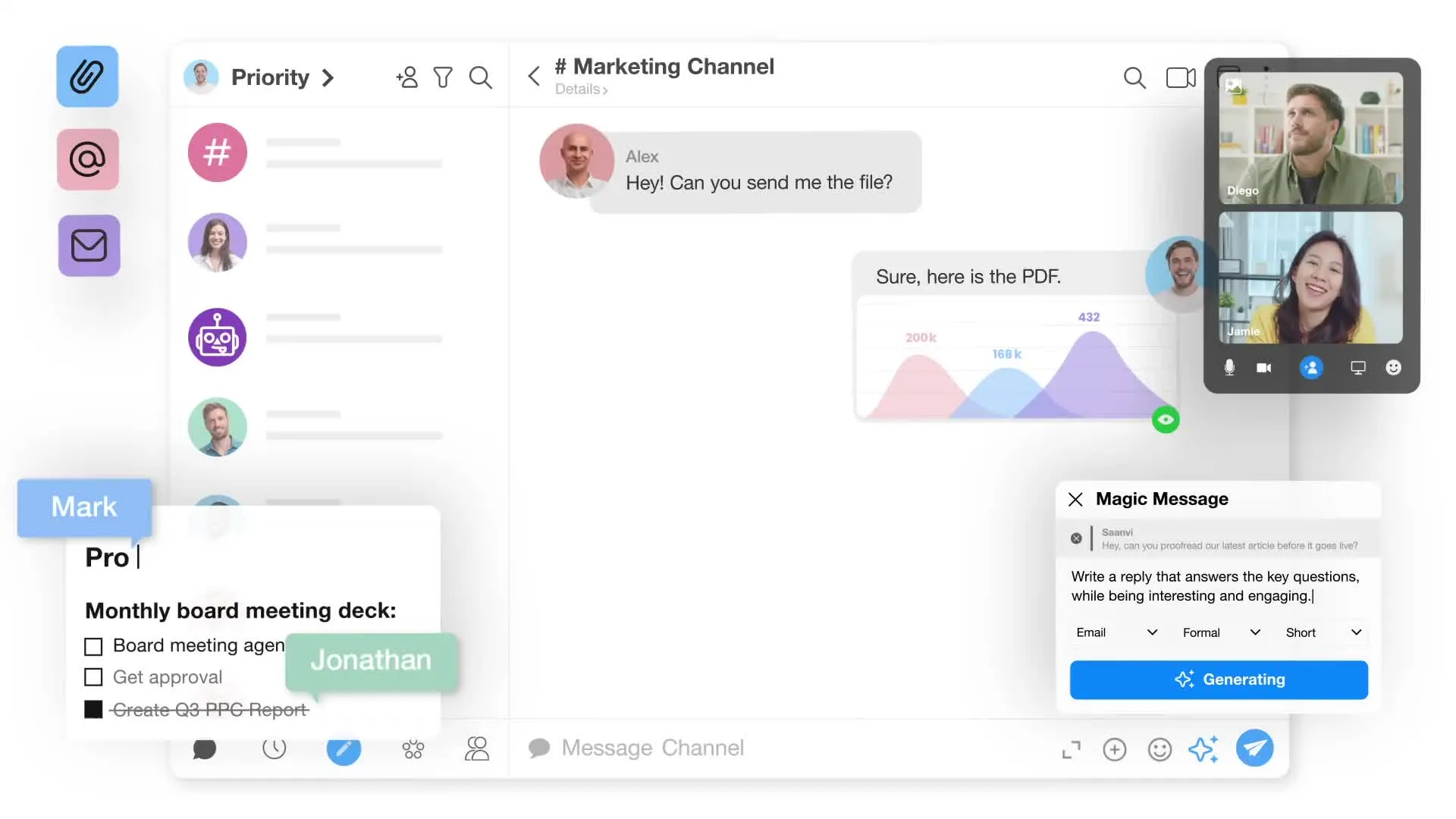WhatsApp alternatives for business teams: Why chat apps don't scale

Why do teams even turn to WhatsApp in the first place?
Everyone already has email, and most companies offer Slack or Teams access. The answer reveals everything wrong with how we’ve been thinking about business communication.
Email feels impossibly slow for quick decisions. Traditional email forces you to write subject lines, format messages formally, and wait for responses that arrive as separate documents you have to mentally reconstruct into conversations.
When you need to ask “Should we go with option A or B?” email makes it feel like you’re writing a memo instead of having a conversation.
Slack and Teams exist, but they cost money per user. WhatsApp is free, everyone already has it installed, and it feels natural for quick back-and-forth. So teams gravitate toward the path of least resistance.
But WhatsApp creates new problems. External partners can’t join easily, important information gets trapped in personal messaging silos, and you’re constantly switching between informal chat and formal business communication. Email remains stuck with 1990s formatting, Slack is expensive, so what’s the solution?
Spike evolved email to feel conversational while working with everyone. Instead of adding another platform, they made email flow like messaging while maintaining universal compatibility. This sparked an entire industry shift toward conversational business communication.
Now you see the entire industry following Spike’s lead. Gmail’s “conversation view” attempts, Microsoft’s “focused inbox,” and even newer tools like Superhuman are all trying to solve the problems Spike solved a decade ago. But they’re still optimizing the old paradigm instead of evolving beyond it.
Platform multiplication vs. communication evolution
Teams looking to move beyond WhatsApp typically choose between two fundamentally different strategies without realizing it.
Communication multiplication means replacing WhatsApp with Slack, Teams, or Discord. You get better business features, but you’re still creating separate communication systems alongside email.
External partners can’t participate naturally, you’re managing multiple platforms, and creating new information silos.
Communication evolution means adopting tools that work with existing business infrastructure while solving the core problems. Instead of fragmenting communication further, you enhance what already works universally.
Spike pioneered communication evolution when they introduced conversational email in 2014. While competitors kept optimizing inbox management, Spike eliminated email threading entirely and solved the actual problem, namely: email splits conversations into separate messages when they should flow chronologically.
6 WhatsApp alternatives for business
1. Spike: The conversational email category creator

- Shows conversations as one flowing timeline instead of scattered email threads.
- Works with any email address without requiring app downloads for external partners.
- AI features like summaries and prioritization work accurately with sequential conversation data
The real breakthrough is Spike’s AI advantage from clean conversation data. When conversations flow sequentially instead of being scattered across threaded documents, AI can actually understand context, relationships, and priorities.
This enables accurate summaries, smart prioritization, and action item detection that’s impossible with traditional email’s fragmented data structure.
External clients see normal emails, your team sees streamlined conversations, and everyone stays in the same communication flow without platform switching.
This isn’t another messaging platform competing for adoption. It’s email that finally works how your brain expects communication to flow, powered by AI that can actually parse conversation meaning because the data isn’t fragmented.
2. Slack: Internal team focus with multiplication paradigm
- Channel organization keeps project discussions focused within the platform.
- Extensive third-party integrations for platform-specific workflows.
- Strong file sharing and project organization inside Slack’s environment.
- Requires separate systems for external communication.
Slack dominates internal messaging because it’s genuinely good at what it does within its own ecosystem.
The problem is that “within its own ecosystem” creates the fundamental issue Spike moved beyond. You’re still running dual communication infrastructure with email for external partners and Slack for internal teams.
The integration story sounds compelling until you realize you’re integrating everything into a platform that external partners can’t access naturally. Email integration feels clunky because you’re bridging two completely different communication paradigms instead of evolving one universal system.
3. Microsoft Teams: Enterprise complexity without evolution insights
- Deep Microsoft 365 integration creates workflows within Microsoft’s environment.
- Enterprise-grade security and compliance features built-in.
- Video conferencing bundled with messaging platform.
- External collaboration requires Microsoft accounts or guest access setup.
Teams works if you’re already living in Microsoft’s world, but it follows enterprise thinking about communication tools rather than communication evolution principles. The complexity increases with every feature instead of simplifying how communication flows.
External collaboration becomes another barrier exercise where everyone needs Microsoft accounts or guest access. The interface feels bloated because it’s optimizing traditional communication paradigms instead of evolving beyond them. It’s enterprise-grade platform multiplication rather than communication evolution.
4. Telegram Business: Enhanced personal messaging paradigm
- Better file sharing capabilities than WhatsApp with larger size limits.
- Broadcast capabilities for company announcements.
- Desktop applications expand beyond phone-only access.
- Still operates as personal messaging platform with adoption barriers.
Telegram offers incremental improvements over WhatsApp but doesn’t solve the fundamental business communication problems. You get better functionality within the same personal messaging paradigm that creates professional communication friction.
External professional contacts still hesitate to join another messaging platform, especially one that mixes personal and business communication. Limited business tool integrations reveal that it wasn’t designed for professional communication infrastructure.
It’s WhatsApp with better features, not business communication evolution.
5. Signal: Privacy-first messaging with minimal business integration
- Strongest privacy protection with end-to-end encryption by default.
- Open-source code allows security auditing.
- No advertising or data collection business model.
- Minimal business features beyond basic messaging.
Signal excels at privacy but misses the communication evolution insights about unified business infrastructure.
If your primary concern is keeping conversations private from data collection, Signal delivers. If you need business communication that works with professional workflows, it creates another silo.
The adoption barriers for external partners unfamiliar with Signal compound the fundamental problem of platform multiplication. You get excellent privacy protection at the cost of business integration and communication flow.
It’s a trade-off that makes sense for specific security-focused use cases but doesn’t solve broader business communication fragmentation.
6. Mattermost: Self-hosted control with traditional paradigm
- Complete data control through self-hosting eliminates vendor dependency.
- Customization capabilities for specific workflows and business needs.
- Open-source foundation prevents vendor lock-in.
- Technical complexity requires significant IT resources for maintenance.
Mattermost appeals to teams that want complete control over their communication infrastructure, but it still follows chat app multiplication rather than communication evolution principles. You get data sovereignty at the cost of complexity and ongoing infrastructure responsibility.
Self-hosting means you’re responsible for maintenance, updates, and scaling instead of focusing on business communication flow. It still creates communication silos separate from email systems rather than evolving existing infrastructure.
The control comes with significant technical overhead that most teams underestimate.
How to evaluate business communication tools using Spike’s evolution framework
Based on feedback from thousands of Spike customers who switched from platform multiplication to communication evolution, here’s a simple checklist for evaluating any business communication tool:
Can external partners use it without downloading apps?
If clients need to create accounts or join new platforms, you’re creating adoption barriers.
Does it eliminate conversation archaeology?
Tools that still make you hunt through scattered messages are just optimizing broken systems.
Will this reduce or increase your total communication platforms?
Each additional tool creates context switching overhead that compounds daily.
Does it work with your existing business systems?
Tools that create informal communication silos separate from your professional infrastructure miss the point.
Can AI actually understand the conversation data?
Fragmented threading across separate messages limits AI effectiveness compared to sequential conversation flows.
Teams that apply this checklist consistently choose communication evolution over platform multiplication.
Why communication evolution beats platform multiplication for business teams
The companies that recognize communication evolution first will have decisive advantages over competitors still juggling multiple platforms and dealing with communication fragmentation overhead.
Spike’s vision for the future of business communication is becoming reality faster than most teams realize. AI-powered communication intelligence emerges when conversation data flows cleanly instead of being scattered across threaded documents.
Spike’s conversational email format enables AI that can actually understand context, detect action items, and prioritize communications accurately.
It maintains the professional infrastructure businesses already use while providing the real-time experience teams actually want. External partners participate naturally.
Integration with business systems happens automatically. Professional standards remain intact.
The shift from tool multiplication to communication evolution is accelerating as teams realize that adding more platforms creates problems rather than solving them.
Communication flows naturally instead of requiring archaeology when you eliminate email threading and show conversations chronologically.
Spike’s vision of conversational email powered by AI represents where business communication is heading. The question isn’t whether this transformation will happen, but whether your team will lead it or follow it.




